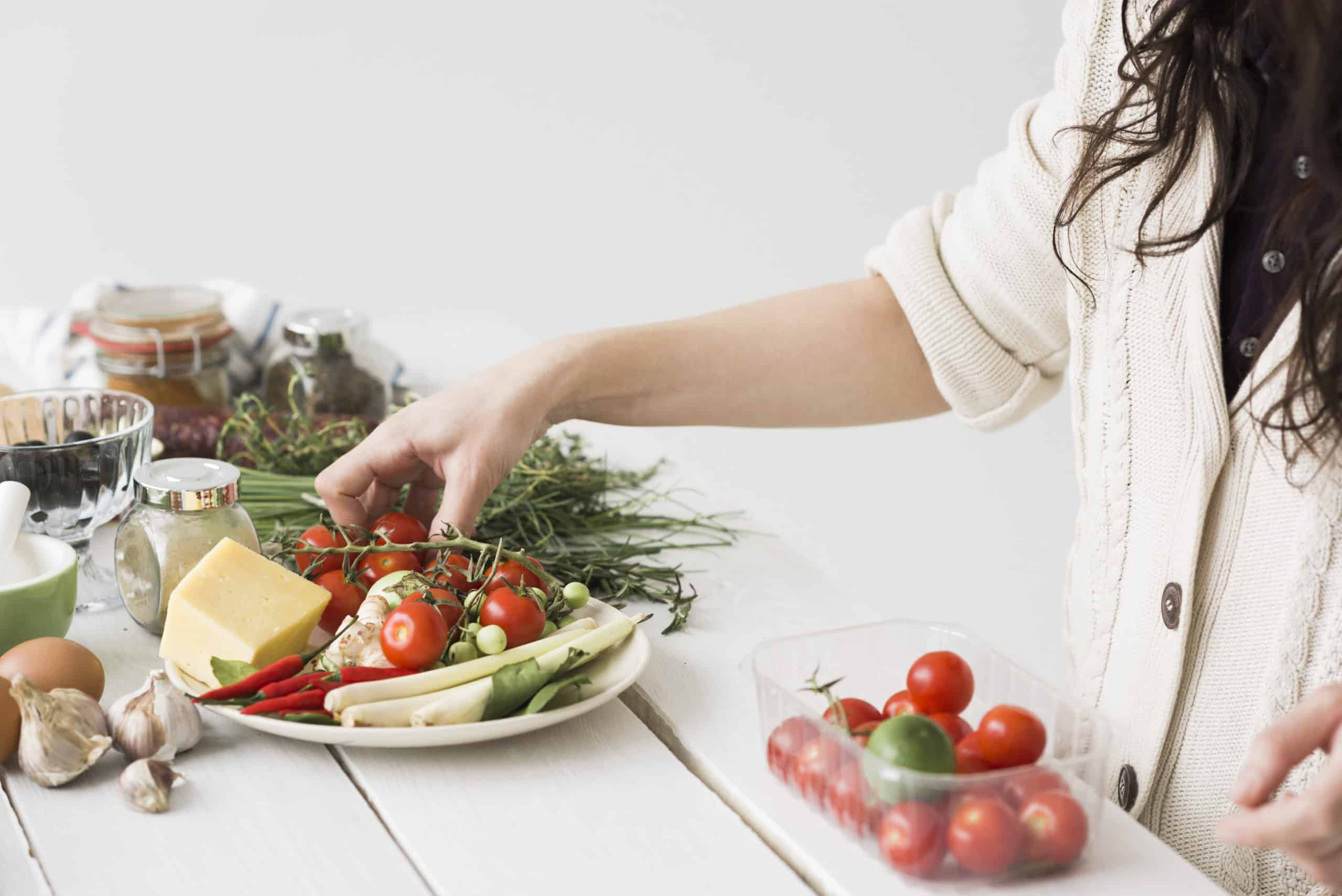- Following the Mediterranean diet is a sustainable way to improve your cardiovascular health—and it could help you lose weight, too.
- Noom Weight works in tandem with the Mediterranean diet, helping you develop healthy habits for the long term.
- Noom’s color-coded food logger and built-in support can help you reach your weight loss goals as you follow the Mediterranean diet.
The Mediterranean diet focuses on whole, nutritious foods—like vegetables, fruit, grains, seafood, and lean meats—based on the traditional diet of people who live near the Mediterranean Sea.
It’s good for cardiovascular health, it may help with weight loss, and we like it because it’s a sustainable way to eat healthy for the long term. If you’re considering trying the Mediterranean diet for weight loss, Noom Weight can help.
We spoke to Noom coach Ashley Bannister, MS, RDN, about how the Mediterranean diet aligns with Noom’s core principles and how the two work together.
Color-coded food logger helps you achieve a balanced diet
Even if you’re closely following the Mediterranean diet, it’s still possible to eat more than your body needs.
When trying to lose weight, “tracking your food can help to keep you accountable to your goals and create more awareness around your food choices,” says Bannister.
And studies show that people who log their food more frequently are likely to lose more weight.
That’s why food tracking and the color system are an important part of the Noom experience.
At Noom, we often talk about calorie density—the number of calories in a specific weight of food. We’ve found that focusing on low-calorie density foods is a good way to lose weight without feeling deprived.
To help Noomers easily identify low-calorie density foods, the Noom food tracker designates every item as green, yellow, or orange.
- Green foods have the lowest caloric density and often the most nutrients—think vegetables (like cauliflower) and whole grains.
- Yellow foods have a slightly higher caloric density—like lean meats and low-fat dairy.
- Orange foods have the highest caloric density—this is where red meat and sweets fall on the spectrum.
For example, there are about 300 calories in a quarter pound of steak, but only 30 calories in a quarter pound of cauliflower.
Both foods deliver important nutrients and can be eaten on the Mediterranean diet. But the cauliflower could fill you up just as much as the steak—for one-tenth the calories.
“Since the Mediterranean diet really emphasizes fruits and vegetables as well as whole grains, the majority of your food choices will likely come from green and yellow foods,” says Bannister.
For example, the diet recommends eating lots of green foods (including cauliflower and other veggies) daily. However, ribeye steak (an orange food) should be limited to a few servings per month.
Keep in mind that the colors don’t determine whether a food is “good” or “bad.” They’re simply a guide for how calorie dense a food is and how much of it you should eat.
As you log your meals, the Noom food tracker calculates your calories for you to help you stay within a healthy range.
Tracking your food also helps increase mindfulness about what and how much you eat, and the color system serves as a visual cue as to which foods you should enjoy in moderation.
Exercise: Time to reflect
Close your eyes. Imagine you live in Greece, and you’re sitting down to a relaxing dinner overlooking the Mediterranean. What would you eat? Bread, olive oil, tomatoes? Fish? Steak?
Remember, all foods are allowed on the Mediterranean diet, but certain items like red meat should be limited to a few times a month.
Lose 48% more weight
with Noom than just meds alone
Daily lessons guide you through the emotional side of eating
At Noom, we know it’s hard work building new habits and making lasting behavioral changes—including adopting the Mediterranean diet.
That’s why our daily lessons are the cornerstone of our program.
“The daily lessons help with understanding nutrition as well as the ‘why’ behind your food choices,” says Bannister. “They can help to identify different behaviors and triggers, and then you can work toward finding strategies to address these challenges.”
For example, you may be in the habit of grabbing a bag of chips from the office vending machine in the afternoon.
However, potato chips and other processed foods aren’t recommended on the Mediterranean diet.
Do you reach for that bag of chips because you’re hungry? Or is it because you walk by the vending machine each afternoon and find it hard to resist?
Noom’s daily lessons address questions like these so you can develop more positive habits—like swapping chips for hummus and veggies if you’re hungry or taking a walk with a work buddy if you’re stressed.
Coaches and peers support you as you work toward your goals
With Noom Weight, you have a built-in support system of coaches and fellow Noomers to help you manage the challenges that may come with adopting the Mediterranean diet.
“If you’re struggling, the coaches can help guide you through the challenges you’re facing and help you to make changes that align with the Mediterranean diet that are sustainable for you,” Bannister says.
Whether it’s cutting out processed foods or breaking through a weight-loss plateau, Noom coaches can support you through rough patches. For example, they can look at your food log and suggest potential tweaks.
“The peer support can be a great sounding board for extra advice,” says Bannister. “You may find others who are interested in the Mediterranean diet in your group, and you can hold each other accountable and provide additional support for each other.”
You might find a buddy to swap Mediterranean diet-friendly recipes with or who will simply celebrate your success with you.
Recipe database makes meal times easy and exciting
If you’re new to the Mediterranean diet, you may not have a lot of experience cooking with its recommended ingredients. Or maybe you’re worried about getting bored eating the same foods over and over.
Noom’s searchable database can help. It has thousands of tried and true Mediterranean-friendly recipes, like this delicious shrimp and orzo salad.
If seafood isn’t your thing, you can search for vegetarian recipes or dishes made with chicken.
The recipes all include calorie counts and even show you where they fall within the color system and your daily calorie budget.
Not sure where to start in the database? Just ask your coach, and they’ll point you in the right direction.
Exercise tracker helps you get active at your comfort level
Exercise is a healthy habit that can increase your longevity and quality of life.
Although exercise isn’t required for weight loss, it is part of the Mediterranean diet lifestyle.
“Exercise would cure a guilty conscience,” the Greek philosopher Plato said. Physical activity is a good way to relieve stress and improve your physical health, too.
That doesn’t mean you need to sign up for a 5K next month. If you’re not already physically active, start slow—find ways to add more movement into your routine in ways you enjoy.
Maybe that’s walking to the market or someplace you’d normally drive, or kayaking on a nearby body of water.
“Part of the lifestyle of a Mediterranean diet is remaining active,” says Bannister. “The exercise tracker can help you to stay accountable to those goals and keep you on track with your exercise routine.”
You can even invite your coach to follow along for extra accountability.
Lose weight with the Mediterranean diet and Noom
Here at Noom, we think the Mediterranean diet is a great way to protect your health without being overly restrictive about what you can and can’t eat.
But if you’re also looking to lose weight, you might need some extra help—that’s what we’re here for.



